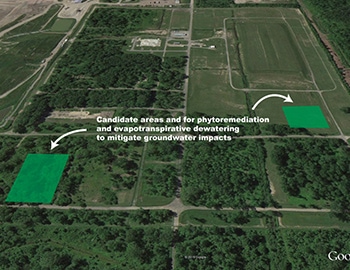The USACE Buffalo District serves as a Proving Ground for the implementation of Engineering With Nature (EWN) principles, advancing a range of innovative projects that enhance ecosystem resilience and provide community and environmental benefits across the Great Lakes region. These projects focus on habitat restoration, flood risk reduction, coastal resilience, and the beneficial use of dredged material.
Buffalo District’s EWN efforts emphasize using natural processes and regional sediment management to restore coastal wetlands, improve habitat connectivity, and protect critical infrastructure. Projects often involve reusing dredged sediments to create or restore wetlands, enhance aquatic habitats, and support biodiversity. Additionally, coastal protection projects integrate nature-based solutions, such as constructing barrier beaches and enhancing breakwater structures, to reduce erosion and improve shoreline stability. Projects such as Unity Island, Braddock Bay, and Cleveland Breakwater demonstrate how natural processes can be harnessed for coastal resilience, habitat restoration, and flood risk management.
Through collaboration with federal, state, and local partners, the Buffalo District has successfully advanced projects that demonstrate the broad benefits of EWN approaches. These efforts contribute to the restoration of vital ecosystems, support recreational activities, boost local economies, and enhance community resilience. LTC Karl Jansen, Buffalo District Commander in 2015, noted:
“Our association with the EWN program affords an excellent opportunity to exercise our regional leadership while demonstrating our commitment to USACE Environmental Operating Principles. Stakeholder partnering and collaboration builds trust with the public we serve and balancing human development with natural systems will preserve the Great Lakes Navigation System’s infrastructure and environment for future generations.”
Engineering With Nature Four Coasts: Great Lakes
A report identifying design concepts for incorporating Engineering With Nature® approaches into the work of the Buffalo, Chicago, and Detroit Districts
Niagara Falls Storage Site
The Niagara Falls Storage Site (NFSS) is located in Lewiston, NY on a 191-acre, federally owned remnant of the larger Lake Ontario Ordnance Works (LOOW) site, which produced trinitrotoluene (TNT) during World War II. The site was used later by the wartime Manhattan Engineer District (MED) to manage and store radiologic residues derived from the early atomic weapons programs. Radiologic source areas and impacted infrastructure have contaminated soils and groundwater in various areas throughout the site. The demonstration project will document how well phytoremediative components minimize contaminant transport and lessen maintenance costs.




